A Complete Facility Inventory tool with RESTful hooks for an FLM interface is basically working. A Manufacturer’s Product Line Input Tool is in the works.

The Audio Maintenance and Set-up sheets from the upcoming SMPTE Modern Calibration Procedures are laid out and working.

Daily/Weekly/Monthly Checklists are working, but need some detail added.

These are all available for testing at the site: DCinemaCompliance.com
The Projectionist Training site DCinemaTraining.com needs 2 more chapters and a QA pass.

Digital Test Tools, the hardware company, has a developed monitoring product waiting for production financing.
Today’s topic is that major tangent of Quality Assurance, Loudness in Cinemas.

We’re not dealing here today with Fletcher Munson Curve-like loudness. We’re dealing with what it is when the audience member says “It’s too loud.”

We’ll start with the reminder that in a quiet room, the mosquito which generates 20/100,000th of a Pascal is too loud (20 x 10-6).
The attempt to create a clever Venn Diagram and a Loudness Matrix turned out to be a ridiculous proposition.

Too many tangents.
Every time I interviewed someone else, it was obvious: It’s tangents all the way around.

One thing was clear throughout: The word of the year is “Annoyance”.
We’ll take up the tangents by Stakeholder segment, attempting to include a
- What Can Be Done or
- What Should Be Studied
for each stakeholder.
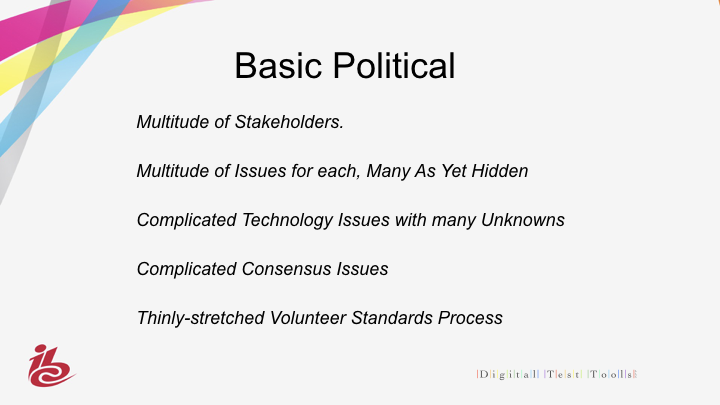
We start with this poignant quote from Hans Zimmer, who has taken a lot of abuse in the last couple years, along with Christopher Nolan.
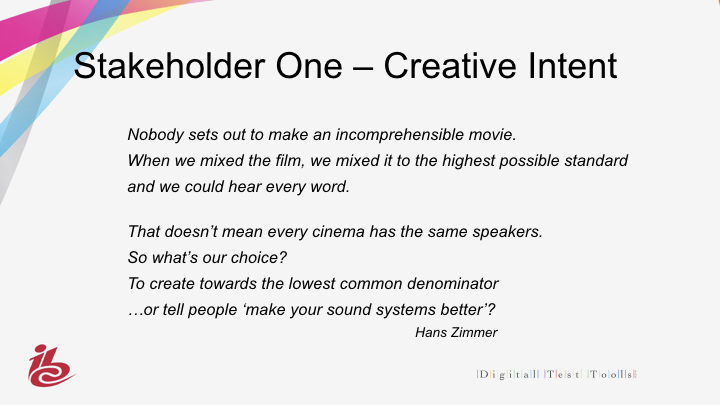
Creative Intent
Not much can be said about this – It is why we chose this field, this technology. For people in sound post production, it means that after years of getting a movie made and locked, music, dialog and effects are forced largely be created and assembled in a few weeks.
A few items on the To Be Studied List is:
- whether mixes are actually louder and
- why are mixes louder, and
- how to communicate better that turning down a mix at the audio processor actually makes the critical dialog more unintelligible.
- to separate fact from anecdote are stories that mixers in the EU are messing with the master gain to match what is happening in auditoriums.
(From several interviews at major stages and mix rooms in LA, this isn’t happening there and most engineers sneer at the idea of it.)
Mixers go to a great deal of trouble to get the mix right then check it at other auditoriums – not just premier rooms but other auditoriums where us common people go. But they bring in their own projectors and tune the room. So it isn’t exactly like what us common people see and hear…note to self – Create studies to find:
- If any producer or director sits for 15 minutes in dim-ish light with dim-ish music until their hearing sensitizes to quiet, then gets blasted by TASA Compliant but fully compressed, loud trailers (not their own).
- Is it the loudness of the trailers that most people respond to as too loud and not the movies
Insert anecdote about how this is what my wife now trusts when I explain it to her while in the theater.
- how many of the public is a complainer
- how many of the public would choose to hear the movies like the Creatives intended.
A side study would be to
- Find out the levels that people are playing these movies (or their music) at when they listen with ear buds on their phones and tablets.
David Monk makes the observation that once he knows what is being said, on his normal TV setup for example, the words are obvious. But sometimes he only finds these obvious words after replaying with subtitles on. Several people interviewed subsequently tell of doing and finding the same thing. David suggests that producers and mixers don’t know what we don’t know, that those words which are obvious to them would be obvious in any circumstance after hearing the words so many times during production and mixing.
For another view of the topic– one which verifies the theory of a prominent studio mixer/exec – I flew in with a women who trained at a major film university, and has subsequently mixed and directed several movies. She wasn’t trained and has never mixed with a VU meter. Instead of building a mix around dialog between -14 to -20 on a VU meter, it is done “at a comfortable level with the peak meter never hitting red.” She has never considered how this could create a big difference in movie loudness.
Tangents and Edge Cases
One horrible stat is that 60% of recent US war veterans have permanent hearing loss or chronic tinnitus ringing in the ears. That’s 600,000 of the former and 850,000 of the latter in the US alone. Add to that, 15% of baby boomers have significant hearing problems, 7.5% of 29-40year olds. UK military and civilian stats are similar in percentage and degree.

The vets problems areorders of magnitude worse than imaginable; it isn’t rare for 25dB loss in one ear and 16dB in the other depending on how they held their rifle or what they typically sat next to. They were instructed to wear ear plugs under their helmets, but the military’s own studies show that finding a target in that condition doesn’t work.
Everyone you ask about cinemas has an opinion on loudness. Not all bad, e.g., one of the scientist interviewed for this segment said that:
The ability to control sound level while watching movies at home is the main reason people like me (no longer teen age) avoid the cinema (movie theaters) altogether.
His idea is to be able to bring and listen through his own bluetooth headphones so he can regulate the volume. Interesting concept.
I spoke to a friend about another friend whose hearing loss is suspiciously at the tone that his wife uses when she is upset. The 2nd friend says that he had the same issue – his wife insisted on tests and his doctor showed the frequency band on his chart where this occurred.
Their loss areas are one thing, but the edge frequencies leading to them are often ‘annoying’. Yet because speaker’s vertical frequency dispersion is nowhere near as smooth as their horizontal dispersion, we commonly place people with sub-prime hearing in sub-prime auditorium seats.
In the practical world, tangents are the all too common edge conditions. Later, we’ll look at some of the impacts that edge conditions might cause in our efforts at building a great room of sound.


Here’s the deal. All vertebrates can regenerate the damaged hair follicles that allow hearing and other sensing (such as the microscopic hairs on the bottom of a fish that senses variations in water currents.)
All vertebrates, except mammals.

This is one view of the sets of hairs that are inside the Organ of Corti, which is part of the cochlea of the inner ear of mammals. We see the longer hairs and other views will show shorter adjacent hairs.

There are about 18-20,000 interconnected hairs. They all contain an even finer stereocilia that does the delicate touching on various parts of adjacent hairs, and which then help convert the stimulus into electrical signals using a transfer of potassium ions from the tip to the base of each hair.

This is an electron microscope view of a frogs hair which work on the same principles but when damaged by trauma, will regenerate. It is in the power of the nerve and its adjacent helper cells to recreate them using a gene factor called ATOH1. There is something in mammals blocking this function.

Another view of good working hairs. You’ll have noticed several in a chevron shape. These are tonotopically organized from high to low frequency.
If you start thinking of ⅓ octave EQ sets, you won’t be too far wrong.

Shown here (at the asterisk) are missing and damaged hairs. After damage the hairs and helper cells seem to maintain some viability for 10 days. Noise-deafened guinea pigs – given 60-70 dB hearing loss by simulated gunfire – can get substantial improvement if the Atoh1-based gene therapy is applied during that time period. Suffice to say, that’s a bumper-sticker statement for a complex decade of study.

Again, good on the right and damaged in the center and left. We’ve all probably heard of missing limb phantom pain? There’s a working theory that these stragglers or the missing hairs themselves initiate a missing limb-style effect, which causes tinnitus.

Yehoash Raphael, the scientists who wants to use his bluetooth headphones in the cinema, makes the unequivocal statement:
There is no viable biological treatment for hearing loss yet.
Dr. Raphael also mentions that current science indicates an important negative outcome of acoustic trauma named Synaptopathy, that is, hidden hearing transmission issues at the nerve itself.
There are hundreds of researchers and many grants funding the laborious process of finding what works and what doesn’t, many using a friendly virus as a carrier for a gene factor.



That’s as far as we’ll follow this tangent. Supporting documents will be put in the package of this presentation on the EDCF website. (Please acknowledge their copyrights if you republish this!)
So, what is the To Be Studied or done in the audience stakeholders domain. Education? Discovery?
What percentage actually complain, but this time, what is their history, and what exactly are they complaining of? Myself, if I get wax build-up, I will hear crackling sounds at loud piano recitals.
Instead of damaging the audio balance and intelligibility of the dialog by turning down the dial, could we map the auditorium for the audience? Would they understand if the cinema manager said that the sound won’t be turn down but that they would guide them to a seat that is less loud, or less loud at various frequencies?
Another tangent: The two reasons that broadcast world’s Loudness science doesn’t apply in cinema; the audience doesn’t have a remote control, and LUFS technology needs modifying for the length of movies. Thus the argument that goes: If I come to the theater and it is too cold, I put on a sweater. If it is always too loud, I put in my ear plugs (or in some pluperfect future, I shall have put on my bluetooth headphones).

Exhibition is very reticent of long drawn out studies becoming a red flag for sensationalists. They are the ones which stand to be most impacted by hyperbole and dissemination of partial truths. Recently, such hyperbolic betrayal came from within the technical community.
Here is what they are afraid of.
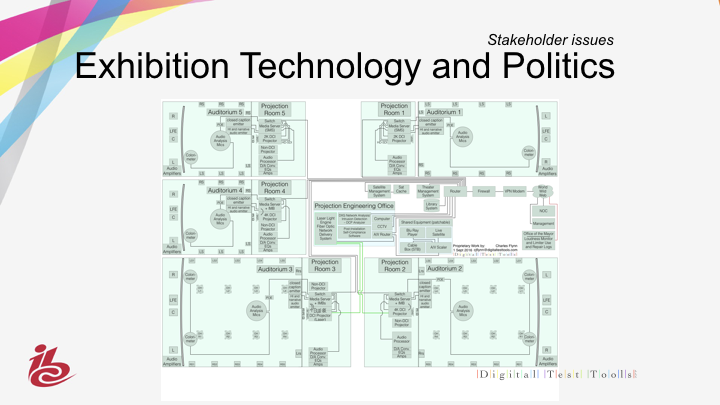
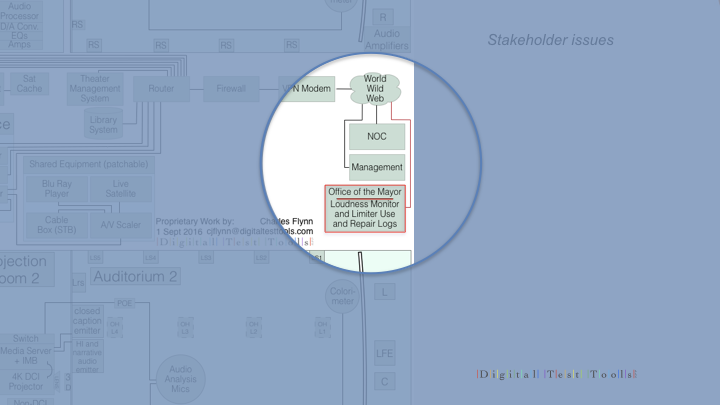
Adding to the already complex structure of a cinema facility, the region of Barcelona passed a law that requires a back channel to the mayor’s office giving loudness data and the logs of the limiters as they kicked in during overages! Only because they were convinced by a certain company that the equipment is not available – such as a 64 channel limiters for an ATMOS system, or even an 8 channel for a 7.1 system, did the enforcement get dropped.
Just as there are no SMPTE or ISO police, there is no NATO or UNIC enforcers. The exhibition community response reverts to the basic premise that there are many commercial decisions that can’t be enforced by fiat. There are benefits and drawbacks to that. As an extreme example, as late as 2007, I installed digital cinema servers into rooms that were just converting from mono.
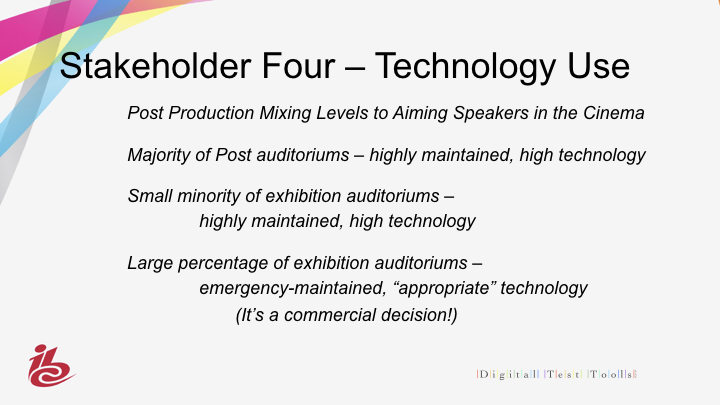
On the other hand, France, the largest EU market by many industry metrics, does have an enforcement arm that monitors exhibition facilities. The CNC normalized the ISO/SMPTE documents, and made them the law of the land. Alain Besse of the CST has begun taking his research project into Loudness all the way back to distortions created in production – microphone choices and placement among other things. He is planning a December symposium to study these and other matters.
There is one other important thing that Alain points out to those that grouse about loud sports and other entertainment venues. Communities are investigating sound not because of cinemas per se. There is fear of an epidemic of destroyed hearing from loud sound – especially low frequency sounds – in public venues, and cinemas are just another public space on the list.
On the To Be Studied List for exhibition is whether short term exposure to 85 and 90 and even 100 dB bursts of sound destroys ears. There is generalized info but not rigorous data. Mothers complain about children who come out with ringing ears, but are those kids also wearing ear buds listening to constant barrages of even louder sounds?
It should be clear that this is not an excuse for badly implemented sound in the auditorium, but what is the reality?
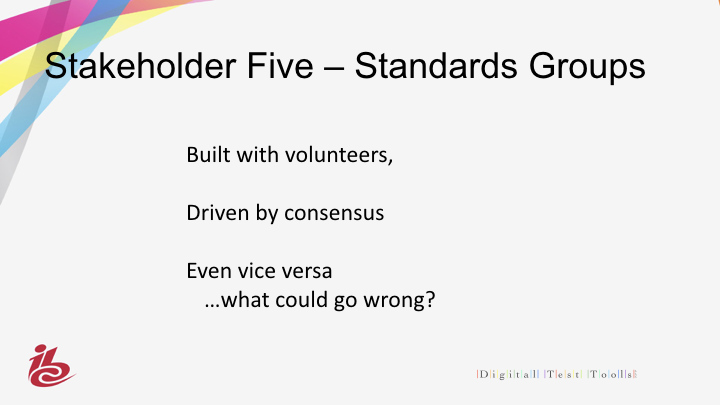
Time, of course.
…and biting off more than can be handled.
The SMPTE group that developed the new digital pink noise standard started nearly 3 years ago. The documents were released many months ago. But for something so primary, there is little public knowledge and very little implementation. The SMPTE store still doesn’t have a standard tone package available for download. A pink standard was Building Block Number One of a list that needs to be done before Loudness can be tackled. Not pointing fingers, but rather pointing out that there is only so much that a volunteer group can do with their spare time. The long-term arc is great, but short-term progress is slow, and expecting engineers to be good at socializing is probably a good source for an oxymoron joke.
People new to the field always ask, “How about transcribing old standards for hearing loss in the workplace?” Well, it turns out that workplace laws – OSHA and the like – were draconian, not in the sense of being onerous for the facility owner, but onerous in the sense of only caring whether the worker still had the bandwidth available to hear a conversation at the end of their work day and at retirement. A worker was considered to have a material hearing impairment when his or her average hearing threshold levels for both ears exceeded 25 dB at 1, 2 and 3 kHz.
And finally, no group wants to walk the path that gets near the briar patch of liability. Societies become litigious for a reason, and despite the extremes that are used to mock the rules on either swing of the pendulum – with real or imagined anecdotes – we as practitioners of the technological arts can’t allow a vacuum to pull in a problem without being ready to correct it with real science in the face of legislators who hire an over ambitious engineering group to “Save The Children”. If we do allow our heads to be put in the sand, we’ll get laws like in Flanders mandating that children’s programs have to be played at essentially 4 on the dial, and adult fare at 5 on the audio processor dial.
Our new contribution to this Quality Assurance situation is a website that offers free DCPs and a comprehensive checklist for non-technical managers.

This Manager’s Walk Through Series gives the facility manager some method and knowledge against the impossible task of judging their auditoriums and communicating with their tech staff.
Each DCP is different, but each has high and low tones played in sequence around the room, with distorted and muted tones for comparison.
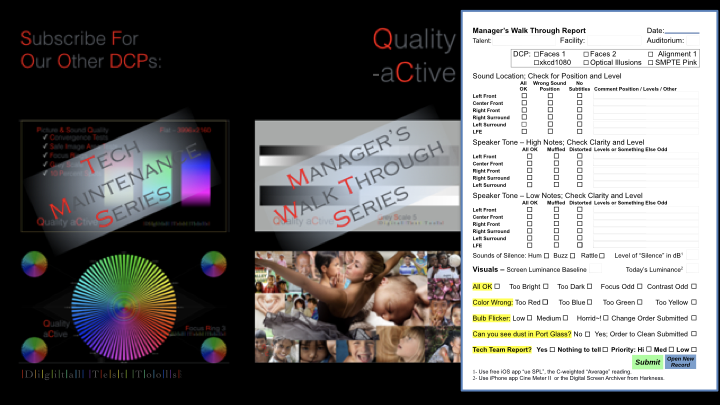
There are graphics included to get the managers used to sensing the problems and the quality potential of their rooms. One DCP uses faces as the empirical standard to judge colors by. Another uses a cool educational graphic from the xkcd.com website, and there are more to come with lessons that fill them in on what they should expect as they build their talents. There’s also a nice dose of the new SMPTE pink noise for sweeping a room and a 2Pop DCP that puts a sync pop into different speakers every 2 seconds.
Download these from cinematesttools.com, password: QA_b4_QC

We look forward to helping you advance the trend of quality assurance in the cinemas. Thank you.
What there was no time to say in a 15 minute presentation:
A mythos has been created that there is a trend toward loudness laws because two, maybe 3, county level (not country level) groups have created laws that regulate audio levels in cinemas. In fact, the Flanders section of Belgium and the Municipality of Barcelona in Spain are the highlights and limits of that trend, and they did so 3 years ago (and only one is, or can be, implemented).
Not to say that there isn’t a good purpose in studying audio levels, but there is no need for the science, fact-based groups to use hyperbole any more than the “gee, we must do something to save the children” or the sensationalist press groups to use hyperbole. Likewise, there is no need to demean the low-knowledge groups as just did, since many are, in fact, properly working in a difficult area – clubs, concerts, sporting arenas, auto racing…) where there is a need to regulate due to entertainment industries that do deliver long and repeating exposure of +110dB levels. That cinemas, which might use brief periods of plus 100dB levels as part of the storytelling experience, get lumped into the same category is all the more reason that the area needs to be examined with the talents we have and not rely upon hope and namecalling.
If Annoyance is the buzzword, it is Distortion that is the hidden hole. In the field of projection we know that there was a long trend of installers specifying projectors down to the level that they just barely made the luminance levels for the size of the screen. This turned around to haunt the industry when exceedingly lower light level 3D became the norm, a norm that could only deliver a set of distortions, from horrible contrast to minimal stereoscopic separation. Those human visual system distortions developed horrible pictures that developed headaches and complaints and eventual collapse of a technology that should have improved but couldn’t due to under performing equipment.
Likewise, under-spec’d (and old) audio equipment delivers distortions of their own, and amplify distortions that are inherent but might go unheard in better systems that correctly play to the sensitivities of the human auditory system. From inexpensive first generation converters to speakers aimed above the heads of the audience, there are numerous potential points of failure that need to be put into a matrix and studied alongside the numerous potential points of failure in the hearing system of the varied audience members. The study that is required is one of a grand scale, and get even grander if there is any attempt to quantify subtle factors dialog intelligibility, loudness and room size (and image size?), their relation to annoyance, accommodation, and audience engagement, and differences between pre-show material and the movie itself, or (shudder to even type it) studying the actual limits for safe listening given the variations of human structure and past listening habits.
It will require a huge conclave of the various sciences. There are many existing groups which have different pieces to match the needed scope of the problem, many which are encumbered by the same time and access problems that SMPTE has, and the political expedient of self-regulation that is demonstrably incapable of reliably playing back movies at the level of artistic intent. Perhaps just creating a group that can generate a public venue to even create an outline of this kind of shared open project would be a first good step.
Finally, more at hand, there are methods that use current tools in the cinema field and variations of new tools developed as a solution for the broadcast field as a beginning for study and development of a valuable metric and algorithm and technique for use, instead of the silly and quite arbitrary Flander-based rules. Mr. Allen has developed a moving time window technique with Leq and Mr. Leem has put forth LUFS-based ideas. These studies, and others as they present themselves, should be open-sourced so that peer review can be done in a more modern and expeditious manner. The first step might be to describe these procedures well onto GitHub.
Good luck to us all.